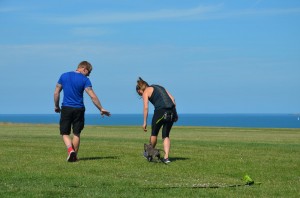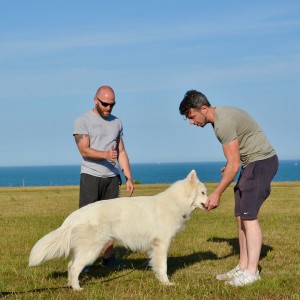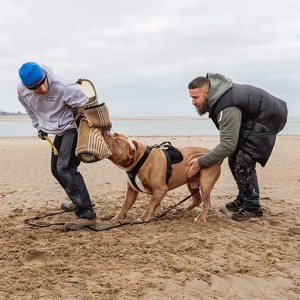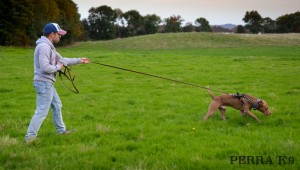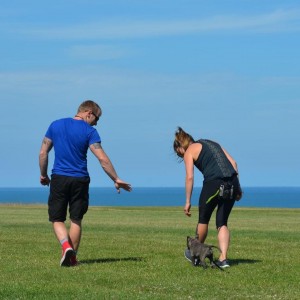If someone asked me what is the best way of training a dog, I would say individual training is number one.
1 on 1 doesn’t mean that we will be training your dog without other dogs, on the contrary, It means that when we start classes with other dogs we will be 100% prepared for it.
This is true especially if you have your first dog or a new puppy because if you are prepared to sacrifice a little bit more time at the beginning to learn the basics about your dog’s behaviour you will reap a great reward in the long term.
Also, this is an excellent opportunity to observe how a trainer works with a dog.
Of course, your dog needs interaction with other dogs, new people and places and you can provide this to your dog on every walk while keeping a few rules.
The most important rule is to adjust the play partner/environment to your dog’s needs. For instance, bringing a puppy to a dog park and allowing it interact with not well-socialized dogs would be a big mistake, but letting him interact with mature and stable dogs in a neutral environment would be a huge advantage.
More to the point a 1 to 1 class is more about giving dog owners the confidence to find the best way of training their dogs. Its about providing a few simple tools to the owner to help them better understand their dog’s behaviour which helps create a better learning environment for both dog and owner. After all the human needs more time to understand their dog’s behaviour than the opposite
Dog Training Perra K9 in Dublin, Malahide.
Dog’s drugs – barking, jumping, pulling, chasing…
I can say that 80 % of the people who come to my training come for these reasons.
The first step to stop your dog’s bad behavior is to understand the reason of this behavior. Is your dog constantly pulling on the lead? It means that your dog is frustraited. Why does frustration occur ? It is quite understandable when we imagine a situation in our life. If you live under stress for a long period you will be depressed/nervous and your body starts to produce the hormone of stress (cortisol) the same happens with a dog. The brain is looking to find a way to relieve the stress. People can produde dopamine and serotonin (hormone of happiness) when they go to the gym, jogging, meet with friends, have a beer or take drugs. This is why people are often addicted to some pleasure. The same happens with a dog and they produce the same hormone when they sniff, chasing cars/tails/dogs…, barking or jumping. Now you can imagine how your dog feels when is doing these all things. There is only one method to help to change this. First learn to understanding your dog’s needs, second build a good relationship and teach your dog how to reduce stress by doing some commands and playing with you. The third is to correct unwanted behavior.
Don’t let your dog take “dog’s drugs” and help your dog stay clean!
A few words about protection training for you guys.
First of all protection training is not for every dog owner and also not for every dog.
Some times people ask me to provide protection training for them and their dogs and I have to decline.
A dog who begins protection training has to have perfect obedience skills and I need to know the owner pretty well. The best way to learn about a person and their dog is to build cooperation with each other by working together for example on an obedience course.
1st- Obedience training is extremely important to prepare the dog’s brain for the stressful work of protection training.
2nd- 80% of protection training is working on a dog’s self-control and obedience skills.
3rd- Temperament. A dog who is fearful, nervous or aggressive and does not have a good bond and working relationship with their owner should not train protection. A good candidate for protection training should be confident, balanced with a positive attitude to work and have trust in their owner.
Olfaction is the most important sense for a dog. It is the first and last thing a dog will do in life.
– Information form sniffing comes to the same area of the brain which is responsible for emotion and feeling pleasure.Mantrailing is a great opportunity for an overreactive dog and it has huge benefits great for a dog with a fear of people and other dogs.
- During the trailing, the dog has to be focused on one activity and ignore all distractions. This gives dog enjoyment in a difficult environment.
– The dog learns concentration
– Self-confidence is the biggest reward. What the dog can achieve during the trail when following a human scent and to finally find the source (human) the dog learns to trust people and feel safe and relaxed around people.
– there is no age limit for the mantrailing training
– Mantrailing is a great way to build a bond between dog and owner.
– Mantrailing burns energy and lets the dog get tired pleasantly.
– In 20-30 minutes of mantrailing the dog is much more tired than after a few hours walk.
Yes, its a dream come true!
When a puppy becomes the newest family member![]()
The best time to get a puppy is when it is 8 weeks old.
IMPRINTING (socialization) time is one of the most important times in its life and right now you are responsible for its behavior. When we talk about socialization we talk about a particular time period. For example, a human being has a 2 year time period for socialization. For a horse, socialization takes 48 hours and for dogs, it is its first 12-14 weeks.
Time is running out and your dog needs to know how to react in every situation so that in the future it knows how to correctly communicate with other dogs on the walk. The sound of traffic, cars, bikes, trucks, joggers is nothing to be afraid of that is why early exposure is so important.
You should know that for a dog the context of a situation is so important this is why we should let the dog learn in a very diversified environment with many distractions. In this small window of socialization, we must let the dog explore the world while they are able to interact with new situations and environments without fear.
Don’t wait, join us today. ![]()
Would you like to know a bit more about the man’s best friend? Here are 10 facts that will surely surprise many of you. Please read on!
Fact no 1
Have you ever wondered why the dog’s nose is wet? It’s essential for dogs as it helps them make sure where a particular scent comes from.
Fact no 2
Studded dog collars were invented in Ancient Greece. Their purpose was to protects dogs against attacks of wolves.
Fact no 3
In Ancient China the last line of the ceasar’s defense was… a Pekingese hidden in his sleeve.
Fact no 4
Working dogs are trained in a way that would allow them to know exactly when they’re on duty. When they have their harness on they know it’s time to work. When the harness is taken off, the dogs are full of energy and begin to play.
Fact no 5
Dogs don’t like to cuddle too much. And even if they do, they aren’t as enthusiastic about it as people or other primates. They treat a paw which is being put on them as a sign of domination.
Fact no 6
Dogs are able to ”understand” up to 250 words and gestures. The level of inteligence of an average dog can be compared to the one of a two-year-old child.
Fact no 7
Dogs have three eyelids. The third one is supposed to moisten and protect the dog’s eye.
Fact no 8
Dalmatians are born completely white.
Fact no 9
Basenji dogs are the only ones that virtually don’t bark.
Fact no 10
It’s much easier for dogs to remember a verbal command when it’s accompanied by a gesture.
What other curiosities would you add to the list? ![]()
From bassets to slim Weimaraners with smooth and shiny coat: dogs are characterised by an amazing variety when it comes to their bodies. The research by The American Naturalist published in 2010 showed that the difference in skull structure of dogs of different breeds are so distinct as it is in case of different species of mammals. For example, the skull of a Scottish Shepherd differs from the skull of a Pekingeses in the same way the cat’s skull differs from the skull of a walrus.
This very diversity makes dogs such a great species for conducting research on genes. It lets researchers match the genes with certain features, for example folds in Shar-Pei dogs or chunkily built Dachshunds.
Source: www.livescience.com
We tend not to appreciate abilities of young dogs.
Hammer, a German shepherd, who has been attending a residential training at Dog Training Center Perra, has reached such level after only two weeks of training ![]()
There are two more weeks of work ahead of us ![]()

![]()
One of the common solution is choosing a dog of the opposite sex, however, sometimes it may not be enough. It’s always better to choose well-balanced dogs, but this may not always be possible. If we already have a nervous, dominant or fearful dog, and we choose a similar one, we may expect a lot of trouble. It’s advisable to choose a calm dog if we have a nervous one, and a compliant one (do not confuse with fearful) for a dominant one.
For a well-balanced dog a newcomer even with some issues may not pose any threat.
There’s a number of puppy personality tests which often vary only in certain details. There are tests aimed at 6- or 7-week-old pups (I prefer doing tests at this age), pups up to 5 months of age and older ones, too. The older a dog is, the more difficult it is to assess its temper at first glance and distinguish between its genetic predisposition and acquired behaviour.
In this case experience may be more useful that certain patterns from books.
Dogs shouldn’t get to know each other at home, especially during feeding time. One of the best ways is to take both of them for a long and exhausting walk so that they can have a chance to meet each other in the most convenient way (body posture, position, letting the other dog smell them). Physical activity helps to release tension and walking together creates the right atmosphere for getting to know a new friend.
Right after the walk, a new dog shouldn’t look around the whole flat. They should be provided with their own bed, bowl with water and food given at regular times in the same place. The bed should be from the beginning associated with safety, shelter and place for relaxation.
In case of separation anxiety, nervousness or messing, a kennel crate may come in handy. The dog is gradually getting used to it and begins to create only positive associations with it. As a result, they will always look for shelter and rest there. It is not allowed to lock dogs inside the kennel crate as a form of punishment.
After two days of getting accustomed to the bed, we may show the dog around the house as if we were showing the flat to another person, that is calmly but without allowing the dog to jump on our bed etc.
If we have more dogs at home, it’s better not to create nervous atmosphere during feeding. We often tend to let dogs wait at the bowl full of food, which is not always good. We may introduce such methods, but as soon as the dog relaxes, we should give them the food. If the dog its too fast and starts to swallow the food, we may interrupt them and repeat the process all over again. It’s a good idea to feed both dogs at the same time to control their behaviour or possessiveness.
I have two dogs at home: Rocky (rottweiler) with a positive attitude towards other dogs and Wafel (Pit Bull) with strong and stable psyche. It would be very unreasonable to introduce a new dog without being able to control dogs’ behaviour. My friends often visit me, I organise residential trainings during which a dog stays at my place together with my dogs 24/7. If I didn’t apply all the suggestions mentioned above myself, I could be in trouble ![]()
Start educating your dog from day one!
Thanks for reading the article and let me wish you a lot of successes when it comes to working with your dogs.


